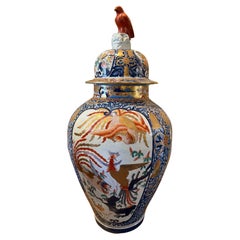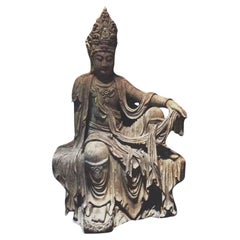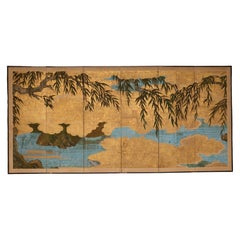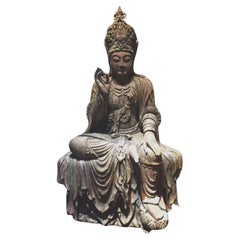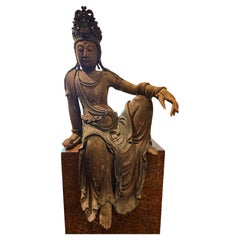Victoria - Asian Art and Furniture
19th Century Chinese Antique Victoria - Asian Art and Furniture
Bronze
Early 20th Century Japanese Victoria - Asian Art and Furniture
Ceramic
Late 19th Century Chinese Qing Antique Victoria - Asian Art and Furniture
Hardwood
1650s Japanese Edo Antique Victoria - Asian Art and Furniture
Gold Leaf
Late 19th Century Chinese Qing Antique Victoria - Asian Art and Furniture
Hardwood
17th Century Chinese Ming Antique Victoria - Asian Art and Furniture
Wood
15th Century and Earlier Chinese Antique Victoria - Asian Art and Furniture
Porcelain
19th Century Japanese Antique Victoria - Asian Art and Furniture
Porcelain
19th Century Japanese Antique Victoria - Asian Art and Furniture
Ceramic
15th Century and Earlier Chinese Antique Victoria - Asian Art and Furniture
Ceramic
1950s Japanese Late Victorian Vintage Victoria - Asian Art and Furniture
Porcelain
19th Century Japanese Antique Victoria - Asian Art and Furniture
Porcelain
Early 18th Century Japanese Edo Antique Victoria - Asian Art and Furniture
Gold Leaf
20th Century Chinese Victoria - Asian Art and Furniture
Porcelain
19th Century Japanese Antique Victoria - Asian Art and Furniture
Porcelain
19th Century Chinese Qing Antique Victoria - Asian Art and Furniture
Bronze
19th Century Japanese Antique Victoria - Asian Art and Furniture
Porcelain
19th Century Japanese Antique Victoria - Asian Art and Furniture
Porcelain
15th Century and Earlier Chinese Ming Antique Victoria - Asian Art and Furniture
Ceramic
19th Century Chinese Qing Antique Victoria - Asian Art and Furniture
Porcelain
19th Century Japanese Antique Victoria - Asian Art and Furniture
Porcelain
Early 19th Century Indian Antique Victoria - Asian Art and Furniture
Foil
19th Century Chinese Antique Victoria - Asian Art and Furniture
Wood
Late 19th Century Chinese Qing Antique Victoria - Asian Art and Furniture
Hardwood
1920s Japanese Vintage Victoria - Asian Art and Furniture
Wood, Lacquer
19th Century Chinese Qing Antique Victoria - Asian Art and Furniture
Porcelain
Early 20th Century Chinese Victoria - Asian Art and Furniture
Bronze
19th Century Japanese Antique Victoria - Asian Art and Furniture
Porcelain
Early 20th Century Chinese Victoria - Asian Art and Furniture
Wood, Lacquer
19th Century Japanese Antique Victoria - Asian Art and Furniture
Porcelain
1920s Japanese Taisho Vintage Victoria - Asian Art and Furniture
Silk
19th Century Japanese Antique Victoria - Asian Art and Furniture
Porcelain
19th Century Korean Antique Victoria - Asian Art and Furniture
Wood
Early 20th Century Japanese Victoria - Asian Art and Furniture
Wood, Lacquer
Late 19th Century Chinese Antique Victoria - Asian Art and Furniture
Porcelain
Early 20th Century Chinese Qing Victoria - Asian Art and Furniture
Metal, Brass
15th Century and Earlier Chinese Archaistic Antique Victoria - Asian Art and Furniture
Bronze
Late 19th Century Chinese Qing Antique Victoria - Asian Art and Furniture
Bronze
20th Century Chinese Victoria - Asian Art and Furniture
Porcelain
Late 19th Century Japanese Meiji Antique Victoria - Asian Art and Furniture
Gold Leaf
20th Century Japanese Victoria - Asian Art and Furniture
Wood
15th Century and Earlier Chinese Ming Antique Victoria - Asian Art and Furniture
Terracotta
18th Century Japanese Antique Victoria - Asian Art and Furniture
Silver Leaf
Late 19th Century Japanese Antique Victoria - Asian Art and Furniture
Porcelain
Late 19th Century Japanese Meiji Antique Victoria - Asian Art and Furniture
Wood
1970s Chinese Vintage Victoria - Asian Art and Furniture
Brass
Early 18th Century Chinese Qing Antique Victoria - Asian Art and Furniture
Ceramic, Porcelain
20th Century Chinese Victoria - Asian Art and Furniture
Glass
Late 18th Century Japanese Edo Antique Victoria - Asian Art and Furniture
Wood, Paper
19th Century Tibetan Antique Victoria - Asian Art and Furniture
Hardwood, Paper
Mid-20th Century Japanese Showa Victoria - Asian Art and Furniture
Wood, Paper
Early 20th Century Chinese Victoria - Asian Art and Furniture
Silver Plate
Early 20th Century Japanese Taisho Victoria - Asian Art and Furniture
1950s German Late Victorian Vintage Victoria - Asian Art and Furniture
Porcelain
1770s Japanese Antique Victoria - Asian Art and Furniture
Gesso, Wood
1970s Hong Kong Chinoiserie Vintage Victoria - Asian Art and Furniture
Plywood, Lacquer
1950s Japanese Late Victorian Vintage Victoria - Asian Art and Furniture
Porcelain
19th Century Chinese Qing Antique Victoria - Asian Art and Furniture
Ceramic
1950s Persian Late Victorian Vintage Victoria - Asian Art and Furniture
Porcelain
17th Century Chinese Ming Antique Victoria - Asian Art and Furniture
Wood
Read More
Symbols of Happiness and Rebirth Adorn This Japanese Satsuma Bowl
Decorated with white cranes and the sought-after thousand-butterflies motif, the Meiji-period vessel offers both a celebration of traditional aesthetics and a clear reflection of the era’s appetite for exquisite export pieces.
Chicago’s Pagoda Red Has a Spirited Mix of Asian Antiques and Bold New Art
For 25 years, gallerist Betsy Nathan has leveraged her keen eye and key connections to bring a unique selection of rare finds to the market.
In L.A., Gallerist JF Chen Has Long Championed Eclectic Blue-Chip Design
Now working alongside his daughter Bianca, dealer Joel Chen has presented a most covetable array of antiques, art and contemporary creations for more than 40 years.
12 Calming Spaces Inspired by Japanese Design
From cherry-blossom-adorned walls paired with glamorous lighting to wood-paneled ceilings above checkerboard-patterned chairs, these 12 spaces seamlessly blend Eastern and Western aesthetics.
Rodrigo Rivero Lake’s Mexico City Showroom Is a Museum-Worthy Trove of Spanish Colonial and Asian Antiques
The dealer and curator has spent the past 50 years amassing a collection of exceptional art, furniture and architectural elements that trace the cultural influence of the Spanish empire from Europe to the Americas and beyond.
16 Refined Asian-Inspired Interiors
These spaces exemplify how Eastern elements elevate a home's decor.

